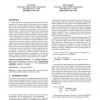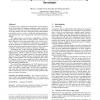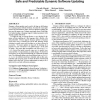15 search results - page 2 / 3 » A novel co-evolutionary approach to automatic software bug f... |
TSE
2010
12 years 11 months ago
2010
Recent advances in mechanical techniques for systematic testing have increased our ability to automatically find subtle bugs, and hence to deploy more dependable software. This pap...
CHI
2010
ACM
13 years 11 months ago
2010
ACM
End-user programmers’ code is notoriously buggy. This problem is amplified by the increasing complexity of end users’ programs. To help end users catch errors early and reliab...
EMSOFT
2008
Springer
13 years 6 months ago
2008
Springer
C's volatile qualifier is intended to provide a reliable link between operations at the source-code level and operations at the memorysystem level. We tested thirteen product...
ASPLOS
2006
ACM
13 years 10 months ago
2006
ACM
Concurrency bugs are among the most difficult to test and diagnose of all software bugs. The multicore technology trend worsens this problem. Most previous concurrency bug detect...
POPL
2005
ACM
14 years 5 months ago
2005
ACM
Dynamic software updates can be used to fix bugs or add features to a running program without downtime. Essential for some applications and convenient for others, low-level dynami...



